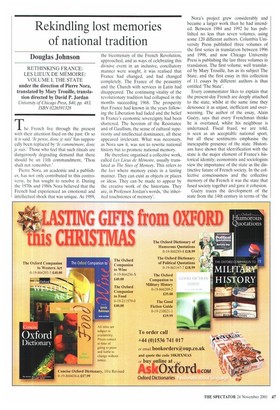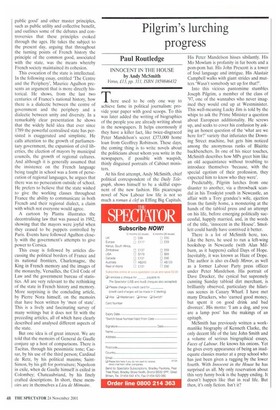Rekindling lost memories of national tradition
Douglas Johnson
RETHINKING FRANCE: LES LIEUX DE MEMOIRE: VOLUME I. THE STATE under the direction of Pierre Nora, translated by Mary Trouille, translation directed by David P. Jordan University of Chicago Press, $40, pp. 483, ISBN 0226591328 The French live through the present with their attention fixed on the past. Or so it is said. le pense, donc je suis' has supposedly been replaced by le commemore, donc je suis.' Those who feel that such rituals are dangerously degrading demand that there should be an 11th commandment, 'Thou shalt not remember.'
Pierre Nora, an academic and a publisher, has not only contributed to this controversy, he has sought to resolve it. During the 1970s and 1980s Nora believed that the French had experienced an emotional and intellectual shock that was unique. As 1989, the bicentenary of the French Revolution, approached, and as ways of celebrating this divisive event in an inclusive, conciliatory manner were sought, it was realised that France had changed, and had changed completely. The France of the peasantry and the Church with services in Latin had disappeared. The continuing vitality of the revolutionary tradition had collapsed in the months succeeding 1968. The prosperity that France had known in the years following the Liberation had faded and the belief in France's economic sovereignty had been shattered. The heroism of the Resistance and of Gaullism, the sense of cultural superiority and intellectual dominance, all these appeared irrelevant. What was necessary, as Nora saw it, was not to rewrite national history but to promote national memory.
He therefore organised a collective work, called Les Lieux de Memoire, usually translated as The Sites of Memory. This refers to the loci where memory exists in a lasting manner. They can exist as objects or places or ideas. They can be made to appear by the creative work of the historians. They are, in Professor Jordan's words, 'the inherited touchstones of memory'. Nora's project grew considerably and became a larger work than he had intended. Between 1984 and 1992 he has published no less than seven volumes, using some 120 different authors. Columbia University Press published three volumes of the first series in translation between 1996 and 1998, and now Chicago University Press is publishing the last three volumes in translation. The first volume, well translated by Mary Trouille, has as its subject The State, and the first essay in this collection of 11 essays by different authors is thus entitled 'The State'.
Every commentator likes to explain that the present-day French are deeply attached to the state, whilst at the same time they denounce it as unjust, inefficient and overweening. The author of the essay, Alain Guery, says that every Frenchman thinks he is overtaxed, whilst his neighbour is undertaxed. Fiscal fraud, we are told, is seen as an acceptable national sport, but all these sentiments emphasise the inescapable presence of the state. Historians have shown that identification with the state is the major element of France's historical identity; economists and sociologists view the importance of the state as the distinctive future of French society. In the collective consciousness and the collective memory of the French it was the state that fused society together and gave it cohesion.
Guery traces the development of the state from the 14th century in terms of 'the public good' and other master principles, such as public utility and collective benefit, and outlines some of the debates and controversies that these principles evoked through the ages. He takes the subject to the present day, arguing that throughout the turning points of French history the principle of the common good, associated with the state, was the means whereby French society maintained its cohesion.
This evocation of the state is intellectual. In the following essay, entitled 'The Centre and the Periphery', Maurice Agulhon presents an argument that is more directly historical. He shows, from the last two centuries of France's national history, how there is a dialectic between the centre of government and the periphery and a dialectic between unity and diversity. In a remarkably clear presentation he shows that the widely held idea that ever since 1789 the powerful centralised state has persisted is exaggerated and simplistic. He calls attention to the growth of parliamentary government, the expansion of civil liberties, the election of mayors by municipal councils, the growth of regional cultures. And although it is generally assumed that the insistence on the French language being taught in school was a form of persecution of regional languages, he argues that there was no persecution outside of school. He prefers to believe that the state wished to give the working classes throughout France the ability to communicate in both French and their regional dialect, a claim with which not everyone would agree.
A cartoon by Plantu illustrates the decentralising law that was passed in 1982, showing that the mayors were joyful when they ceased to be puppets controlled by Paris. Events have followed Agulhon closely with the government's attempts to give power to Corsica.
This essay is followed by articles discussing the political borders of France and its national frontiers, Charlemagne, the King in French memory and the images of the monarchy, Versailles, the Civil Code of Law and the government bureau of statistics. All are very relevant to the rethinking of the state in French history and memory. More surprising is the concluding article, by Pierre Nora himself, on the memoirs that have been written by `men of state'. This is a lively and fascinating survey of many writings but it does not fit with the preceding articles, all of which have clearly described and analysed different aspects of the state.
But one idea is of great interest. We are told that the memoirs of General de Gaulle conjure up a host of comparisons. There is Tacitus, through his pessimistic tone; Caesar, by his use of the third person; Cardinal de Retz, by his political maxims; SaintSimon, by his gift for portraiture; Napoleon in exile, when de Gaulle himself is exiled in Colombey; Chateaubriand, by his finely crafted descriptions. In short, these memoirs are in themselves a Lieu de Memoire.



















































































 Previous page
Previous page